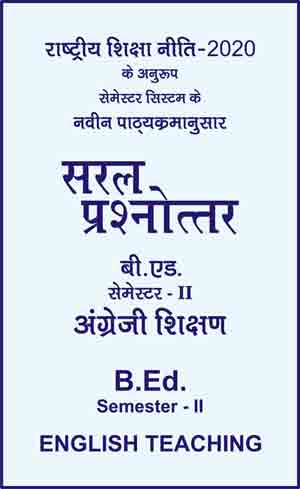|
बी एड - एम एड >> बीएड सेमेस्टर-2 अंग्रेजी शिक्षण बीएड सेमेस्टर-2 अंग्रेजी शिक्षणसरल प्रश्नोत्तर समूह
|
5 पाठक हैं |
||||||
बीएड सेमेस्टर-2 अंग्रेजी शिक्षण - सरल प्रश्नोत्तर
Question- What do you mean by audio-visual aids? Give their classification.
Or
Discuss the different audio-visual aids that can be used in teaching of English.
Ans.
Classification of Audio-visual Aids: There are a lot of patterns to classify the audio-visual aids:
(a) On the basis of senses: On the basis of senses the teaching-learning aids may be classified into the following categories:
(i) Audio aids: This type of teaching aids facilitate audio senses and encourage the listening ability. The audio sense is active in lecture and question-answer method of teaching so, the use of tape-recorder, radio, recorder, gramophone etc. make the students more active and attentive in classroom. The students take more interest when lesson is taught with the help of these aids. These aids are used to realize the cognitive and affective objectives only and can’t be used in achieving psychomotor objectives.
(ii) Visual aids: The visual aids encourage the seeing function and thus facilitate the visual sense. The visual sense i.e., eyes of the students become more active when teacher uses models, charts, maps, graphs etc., in his teaching process. These aids play an important role in the teaching. The visual teaching aids play a significant role in teaching of geography, physics, chemistry, english, biology, economics etc. These aids are more economical and useful than visual aids. These are generally used in all teaching situations. The visual teaching aids are used to achieve the cognitive objectives but affective and psychomotor objectives can also be achieved.
(iii) Audio-visual aids: These aids are used to facilitate both audio and visual senses and encourage listening and observing functions. These aids involve more than one sense simultaneously and learner becomes more active. These aids are quite more effective and useful than audio aids and visual aids. The audio-visual aids develop the perception of the learner which is the basis for the understanding of any concept. Educational films, television etc. are the examples of audio-visual aids.
(b) Classification on the basis of technology: On the basis of technology, teaching-learning aids may be classified into following two categories:
(i) Software aids: These aids include printed aids like figure, graph, chart, book, map, cartoon etc.
(ii) Hardware approach: These aids consist of radio, television, teletecture, record player, epidiascope, projector, computer etc.
(c) Classification on the basis of projection: These are further of two types:
(i) Projected aids: All the materials that can be projected, fall under this class. These aids include slide, filmstrips etc.
(ii) Non-projected aids: This category includes charts, figures, models, specimen etc. which can not be projected.
(d) Classification by N.C.E.R.T. : The educationists of N.C.E.R.T. classified these aids into the following six categories :
(i) Graphic aids :
Photograph
Chart/Poster
Graph
Cartoon
Flash cards
Diagram
Map
Comics
(ii) Display Board aids :
Black-board
Bulletin-board
Peg board
Flannel board
Magnetic board
(iii) Three dimensional aids :
Model
Specimen
Real objects
Pipets
(iv) Projected aids :
Filmstrips
Slide
Films
Projector
(v) Audio-aids :
Radio
Recorder
Television
(vi) Process-aids :
Demonstration
Field trip
Exhibition
Dramatisation
Excursion
(e) Classification on the basis of use : On the basis of uses and utility, teaching-learning aids may be classified into four categories which are shown below :
(i) Traditional aids :
Black-board
Books
Magazines
(ii) Visual aids :
Objects
Graph
Chart/Poster
Specimen
(iii) Mechanical aids :
Radio
Teaching machine
Magic box
Film and video
Tape-recorder
Projector
Epidiascope
(iv) Other aids :
Field trip
Exhibition
Museum
(f) Classification by Kochar : S.K. Kochar has classified the audio-visual aids into the following five types :
(i) Auditory aids (Aids through the ear) :
Phonograph
Radio
(ii) Visual aids (Aids through the eye) :
Motion pictures
Stereoscope
Flannel board
Chalk board
Camera
Bulletin board
Pictorial materials
Miniatures
(iii) Audio-visual aids (Aids through the eye and ear) :
Sound-motion pictures
Television
(iv) Aids through activity :
School journeys
Collection of objects,
specimens,
model
(v) Miscellaneous :
Dramatization
Booklet
Newspapers
Magazines
|
|||||













